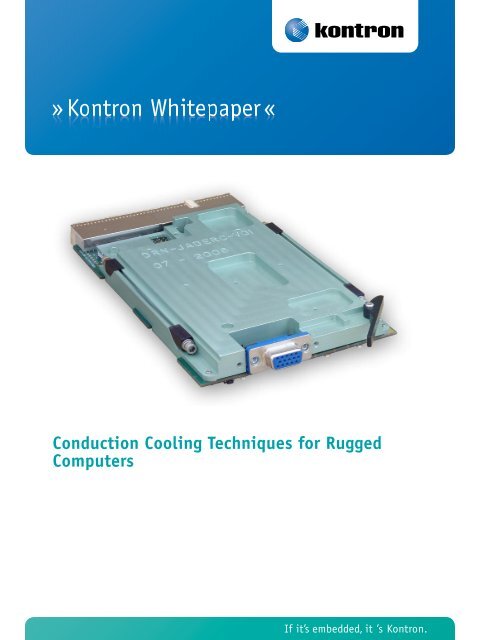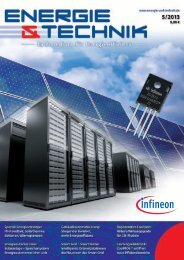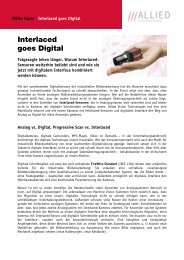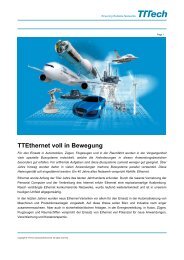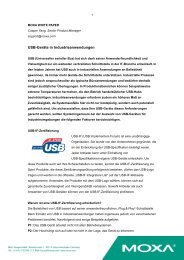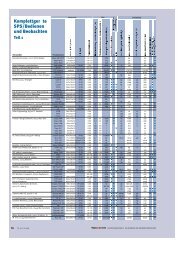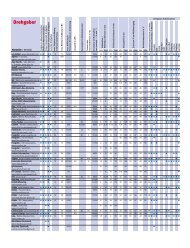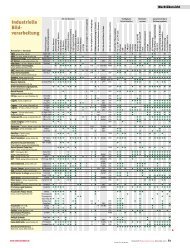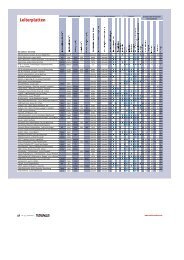Conduction Cooling Techniques for Rugged Computers - Kontron
Conduction Cooling Techniques for Rugged Computers - Kontron
Conduction Cooling Techniques for Rugged Computers - Kontron
Create successful ePaper yourself
Turn your PDF publications into a flip-book with our unique Google optimized e-Paper software.
<strong>Conduction</strong> <strong>Cooling</strong> <strong>Techniques</strong> <strong>for</strong> <strong>Rugged</strong><br />
<strong>Computers</strong><br />
If it’s embedded, it ’s <strong>Kontron</strong>.
<strong>Kontron</strong> Whitepaper<br />
<strong>Conduction</strong> <strong>Cooling</strong> <strong>Techniques</strong> <strong>for</strong> <strong>Rugged</strong><br />
<strong>Computers</strong><br />
<strong>Conduction</strong> cooling <strong>for</strong> modular embedded computers have been used<br />
<strong>for</strong> many years in applications where air cooling is not appropriate.<br />
Standardization ef<strong>for</strong>ts in that domain have early helped to maintain<br />
interoperability of COTS products. The conduction cooled design<br />
techniques are continuously improving to meet the requirements <strong>for</strong><br />
higher power dissipation and lower price.<br />
Contents<br />
<strong>Conduction</strong> <strong>Cooling</strong> <strong>Techniques</strong> <strong>for</strong> <strong>Rugged</strong> <strong>Computers</strong> . . . . . . . . . . . . . . . . 1<br />
Summary . . . . . . . . . . . . . . . . . . . . . . . . . . . . . . . . . . . . . . . . . . . . . . . . 2<br />
Contents . . . . . . . . . . . . . . . . . . . . . . . . . . . . . . . . . . . . . . . . . . . . . . .. . 2<br />
Why using conduction cooled board computers . . . . . . . . . . . . . . . . . . . . . 3<br />
COTS approach to conduction cooled modular computers. . . . . . . . . . . . . . . 3<br />
Further refinements <strong>for</strong> conduction cooled heat drain. . . . . . . . . . . . . . . . . 4<br />
Extending the thermal per<strong>for</strong>mance with heat pipes. . . . . . . . . . . . . . . . . . 4<br />
Author´s Bio . . . . . . . . . . . . . . . . . . . . . . . . . . . . . . . . . . . . . . . . . . . . . . 4<br />
About <strong>Kontron</strong> . . . . . . . . . . . . . . . . . . . . . . . . . . . . . . . . . . . . . . . . . . .. . 5<br />
<br />
www.kontron.com
<strong>Kontron</strong> Whitepaper<br />
Why using conduction cooled board<br />
computers<br />
<strong>Conduction</strong> cooled boards have traditionally been employed<br />
in applications where heat evacuation with an airflow is<br />
impractical. These include situations where there is no air<br />
available such as space applications, where the air is not<br />
efficient enough to carry all the calories at the right speed.<br />
This also includes environments where creating an airflow<br />
with moving parts would affect the reliability of the system.<br />
<strong>Computers</strong> running in harsh environments can often<br />
benefit from conduction cooled techniques. Extended board<br />
temperature specifications, <strong>for</strong> example between -40 and<br />
85°C, require optimized thermal per<strong>for</strong>mance to lower the<br />
temperature difference between the silicon dies and the<br />
environment. But also, their reliability is often critical and<br />
the high level of shocks and vibrations would prohibit the<br />
use of fans.<br />
Another situation where conduction cooling is helpful, is<br />
the design of a sealed computer box to avoid exposing the<br />
electronics to dust or contaminant, <strong>for</strong> example kerosene<br />
vapours.<br />
COTS approach to conduction cooled<br />
modular computers<br />
COTS mechanical rules <strong>for</strong> conduction cooled modular board<br />
computers in the eurocard <strong>for</strong>m factor were standardized<br />
in 1992 by IEEE Std 1101.2-1992 in order to ensure<br />
interoperability and common good practices. Thanks to this<br />
standard, conduction cooled boards and chassis selected<br />
from different vendor catalogues all work together.<br />
This IEEE standard mainly defines the mechanical<br />
dimensions and thermal interfaces <strong>for</strong> eurocards like VMEbus<br />
or other <strong>for</strong>m factors such as CompactPCI. It was originally<br />
intended to evacuate the heat to the chassis from the<br />
bottom of the PCB plugged in module and along the card<br />
guides. In that case, the PCB is designed with an embedded<br />
conductive layer in order to move the calories toward the<br />
PCB edges.<br />
As the thermal dissipation requirements increase, this<br />
thermally conductive PCB layer is often replaced with a<br />
metal drain, machined from aluminium, which covers the<br />
whole top side of the board. And any direct contact of the<br />
electronic components is through a thermal paste.<br />
This technique, sometimes called the ruggedizer, not only<br />
improves thermal per<strong>for</strong>mance, but also helps to sustain<br />
a high level of shock and vibration by providing a rigid<br />
frame to attach the board at multiple points. It also helps<br />
the board vendors to offer the same electronic design in a<br />
standard air cooled and conduction cool version. The only<br />
penalty to the standard air cooled design being not to place<br />
components too close to the card guide area. Figure 1 shows<br />
the <strong>Kontron</strong> PowerEngine7 board running at up to 1 GHz, as<br />
an example of the ruggedizer which is compatible with IEEE<br />
Std 1101.2.<br />
Figure 1: <strong>Conduction</strong> cooled board computer compatible<br />
with IEEE Std 1101.2: PowerEngine7 from <strong>Kontron</strong><br />
The wedge lock mechanism along the card guides, defined<br />
in the norm, secures the card inside the chassis and applies<br />
pressure on the thermal interface between the drain and<br />
guide in order to improve the thermal per<strong>for</strong>mance.<br />
In addition to IEEE Std 1101.2, other international<br />
standards are available to define the conduction cooled<br />
practices <strong>for</strong> modular computers, such as VITA 47 and<br />
VITA 20. ANSI/VITA 47-2005[R2007]. These standards<br />
normalize the different severity level of environments <strong>for</strong><br />
air cooled, conduction cooled, liquid cooled and spray<br />
cooled boards. Related standards not addressed in this<br />
paper, and specifying conduction cooled implementations<br />
<strong>for</strong> Eurocard, are VITA 48 describing VPX VITA 46 mechanical<br />
implementations and VITA 57 dealing with FMC mezzanines.<br />
ANSI/VITA 20-2001[R2005] defines the rules <strong>for</strong> designing<br />
conduction cooled PMC mezzanine cards and their associated<br />
mother boards. The heat of the daughter cards is propagated<br />
to the motherboard through two mandatory thermal bars<br />
and two optional thermal ribs, arranged on Figure 2<br />
representing a conduction cooled graphics card, the <strong>Kontron</strong><br />
XMC-G72. This graphics card, engineered <strong>for</strong> air cooled and<br />
conduction cooled environment, features a state–of-theart<br />
dual display capability based on ATI HD2400 graphics<br />
processor.<br />
Figure 2: <strong>Conduction</strong> cooled graphics PMC mezzanine, the<br />
<strong>Kontron</strong> XMC-G72.<br />
<br />
www.kontron.com
<strong>Kontron</strong> Whitepaper<br />
Further refinements <strong>for</strong> conduction<br />
cooled heat drain<br />
To limit the cost of qualifications and inventories, modular<br />
boards offered in both air cooled and conduction cooled<br />
versions, are sometimes build from a mixed PCB outline<br />
allowing both types of cooling. This is illustrated in Figure<br />
3 with the <strong>Kontron</strong> ITC-320, a single or dual core processor<br />
board featuring an Intel® Core2 Duo, Core Duo or Intel®<br />
Celeron® M processor in the 3U CompactPCI <strong>for</strong>m factor.<br />
Figure 4: PowerNode5 dual PowerPC processor board running<br />
at 1.6 GHz in conduction cooled environment<br />
Figure 3: The <strong>Kontron</strong> ITC-320 Intel® Core2 Duo processor<br />
board<br />
It can also be noted on Figure 3 that half of the wedge<br />
lock mechanism is integrated inside the thermal drain.<br />
This feature reduces the thermal impedance of the drain to<br />
the chassis by increasing the section of the thermal path<br />
available to conduct the heat. In other words, it allows to<br />
reduce the component keep out area along the sides of the<br />
card while increasing the thermal conductivity.<br />
Extending the thermal per<strong>for</strong>mance<br />
with heat pipes<br />
For the highest thermal dissipation and thermal density,<br />
heat pipes can be very effective in conduction cooled<br />
environments. Figure 4 shows the <strong>Kontron</strong> PowerNode5<br />
processor board which features two 64 bits PowerPC<br />
processors running at 1.6 GHz in a conduction cooled<br />
environment.<br />
The calories generated by each processor with a significant<br />
thermal density are evacuated through two heat<br />
pipes towards each side of the board. The first benefit of<br />
this is to take advantage of the extraordinary high<br />
thermal conductivity of heat pipes as compared to passive<br />
metal. The second benefit of these heat pipes is<br />
that they provide a floating copper caps to contact the<br />
dissipating die with precision, limiting heat losses at the<br />
die thermal interface.<br />
It should be noted that the heat pipes are arranged in a<br />
symmetrical topology from the die, allowing the assembly<br />
to be less sensible to gravity or acceleration. Regardless<br />
of the card orientation, if one heat pipe becomes less<br />
efficient because of acceleration or gravity, the symmetrical<br />
heat pipe will compensate through improved thermal<br />
per<strong>for</strong>mance.<br />
This compensation effect has been clearly validated by<br />
testing the equipment in a centrifuge.<br />
Another key feature of the heat pipes is the capability to<br />
pre heat a device cooled by a heat pipe up to a temperature<br />
that is compliant to its specification be<strong>for</strong>e applying<br />
the power to the board. When the board is at very low<br />
temperature, the heat pipe internal liquid is frozen, hence,<br />
it is easier to heat the die with an external device with a<br />
good efficiency since the thermal path to the cold wall is<br />
blocked.<br />
Note to Readers: Some of the characteristics described in<br />
this article are protected through pending patents<br />
of <strong>Kontron</strong>.<br />
Author´s Bio<br />
Serge Tissot,<br />
Manager of the Board<br />
<strong>Computers</strong> department of<br />
<strong>Kontron</strong> Modular <strong>Computers</strong><br />
S.A.S.<br />
<br />
www.kontron.com
<strong>Kontron</strong> Whitepaper<br />
About <strong>Kontron</strong><br />
<strong>Kontron</strong> designs and manufactures standard-based and custom embedded and communications<br />
solutions <strong>for</strong> OEMs, systems integrators, and application providers in a variety of markets.<br />
<strong>Kontron</strong> engineering and manufacturing facilities, located throughout Europe, North America,<br />
and Asia-Pacific, work together with streamlined global sales and support services to help<br />
customers reduce their time-to-market and gain a competitive advantage. <strong>Kontron</strong>’s diverse<br />
product portfolio includes: boards and mezzanines, Computer-on-Modules, HMIs and displays,<br />
systems, and custom capabilities.<br />
<strong>Kontron</strong> is a Premier member of the Intel® Embedded and Communications Alliance.<br />
The company is a recent three-time VDC Platinum vendor <strong>for</strong> Embedded Computer Boards.<br />
<strong>Kontron</strong> is listed on the German TecDAX stock exchange under the symbol „KBC“.<br />
For more in<strong>for</strong>mation, please visit: www.kontron.com<br />
Corporate Offices<br />
Europe, Middle East & Africa<br />
Oskar-von-Miller-Str. 1<br />
85386 Eching/Munich<br />
Germany<br />
Tel.: +49 (0)8165/ 77 777<br />
Fax: +49 (0)8165/ 77 219<br />
sales@kontron.com<br />
North America<br />
14118 Stowe Drive<br />
Poway, CA 92064-7147<br />
USA<br />
Tel.: +1 888 294 4558<br />
Fax: +1 858 677 0898<br />
sales@us.kontron.com<br />
Asia Pacific<br />
17 Building,Block #1,ABP.<br />
188 Southern West 4th Ring Road<br />
Beijing 100070, P.R.China<br />
Tel.: + 86 10 63751188<br />
Fax: + 86 10 83682438<br />
kcn@kontron.cn<br />
#Whitepaper - <strong>Conduction</strong> Colling <strong>Techniques</strong> <strong>for</strong> <strong>Rugged</strong> <strong>Computers</strong># 27012009PDL<br />
All data is <strong>for</strong> in<strong>for</strong>mation purposes only and not guaranteed <strong>for</strong> legal purposes. Subject to change without notice. In<strong>for</strong>mation in this datasheet has been carefully checked and is<br />
believed to be accurate; however, no responsibilty is assumed <strong>for</strong> inaccurancies. All brand or product names are trademarks or registered trademarks of their respective owners.<br />
<br />
www.kontron.com


